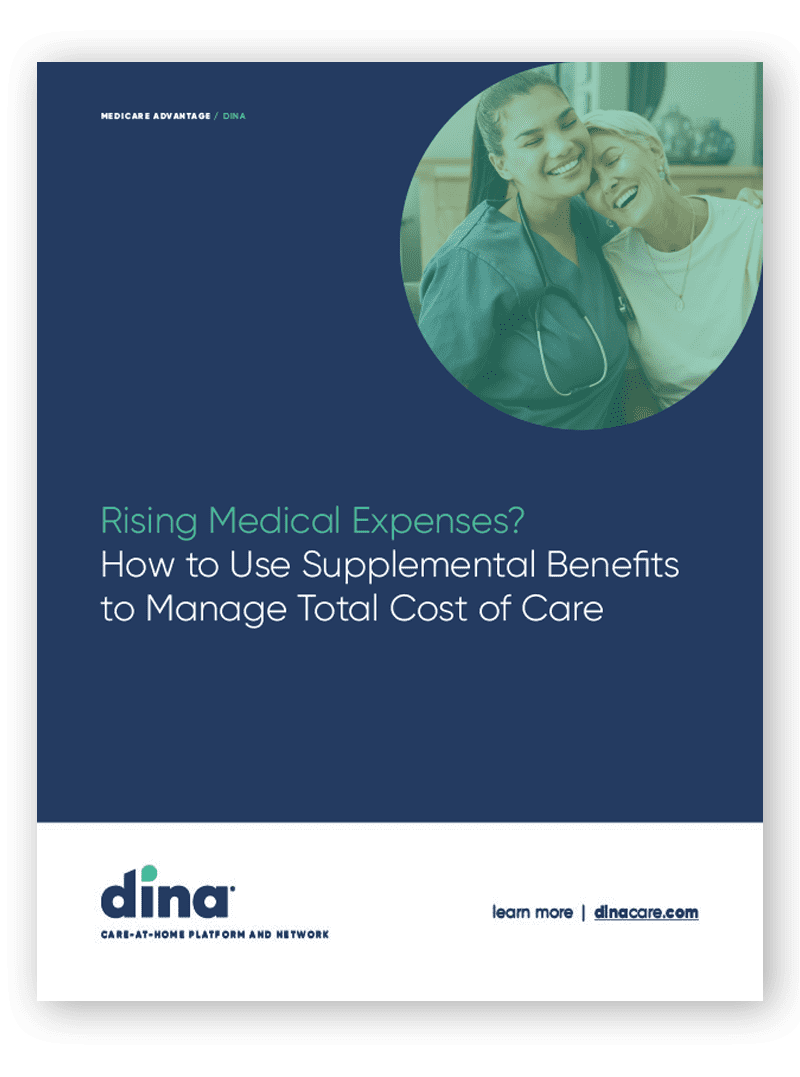
The rapid growth of our aging population is reshaping how we think about administering long-term care in the home. But accessing in-home services remains a massive problem. Persistent workforce shortages and rising care costs present hurdles. And new mandates from CMS raise the bar around transparency, access, and reliability.
Dina President Sherman Sanchez said health plan leaders can prepare to meet the moment.
“Payers may see more value in aligning benefits with target cohorts rather than follow the ‘all things to all people’ approach of recent years,” Sanchez said. “Insurers may become more selective about how many plans and benefits they offer, as medical costs rise and policymakers reconsider the value of supplemental benefits.”
Talk about supplemental benefits and value-based care programs.
Many health plans are leveraging supplemental and home-based benefits as an integral part of their value-based care strategies and programs. They’re offering preventative interventions including ADL support through homemaker and home health aide services, caregiver support and respite services, home safety evaluations and home modifications, healthy meal programs post-hospitalization, and transportation for both medical and non-medical appointments.The good news is that research shows that these interventions work when accessible and managed correctly. Studies show a consistent improvement in outcomes through avoidable ED visit and hospitalization reductions, delayed progression to long-term care, and an associated bump in satisfaction.
What do you say to health plans that are cutting benefits?
The challenge for many health plans, and CMS reinforces this stance, is that supplemental benefits are often underutilized or may not show a clear impact or return on investment. They are often not tied to a targeted population’s health outcomes. Before cutting benefits, I’d challenge health plan leaders to evaluate ways to use their home-based or non-medical benefits to really create value, and to drive smart utilization of non-medical benefits to address their value-based care objectives.
Before cutting benefits, I’d challenge health plan leaders to evaluate ways to use their home-based or non-medical benefits to really create value.
The “80-20” provision raises concerns about access to home care.
Home care agencies feel the 80/20 rule will force many companies to close their doors and go out of business, further worsening the access to home care for Medicaid members. CMS believes this is a way to bring more caregivers into the profession to meet the demands of a growing Medicaid segment that needs home care. We believe technology has a role to play here to help create efficiencies and grow capacity. This addresses the concerns on both sides of the issue.
One of the many motivators for passing the rule is the potential to delay progression to long-term care facilities by providing more care in the home and reducing total spend. There is encouraging data that show that a Medicaid member stays in their home 21 months longer versus moving into a nursing home when the appropriate home-based services and interventions are activated.
How does the provision address workforce challenges?
Health plans and agencies are trying to improve access to personal care in a meaningful way. Recognizing that, in most cases, more of the reimbursement dollar will go directly to the caregiver, it is critical to streamline the coordination between health plans and agencies.
Agencies will need easier mechanisms to coordinate and work with health plans. Administrative costs have to go down to make the margins work for them to be able to support Medicaid patients.
The 80-20 rule means that plans are now incentivized to be thoughtful about driving access without introducing operational burden on their provider network. Investing in tools that make it easy to find the right agencies for members’ needs, and then streamlining the acceptance and intake processes will help agencies manage their margins.
What’s next for Dina?
Solving access to in-home care is what we’ve been focused on since day one. But access to care is a broader issue. Now our customers are asking us to broaden our aperture to include not only in-home services, but to support other use cases such as primary care-driven specialty care referrals. New research shows that patient wait times for medical appointments average 38 days across 11 specialties, so it’s a big problem to solve.
What gets you excited about your role at Dina?
Nearly everyone has had this problem of being a caregiver for a family member or loved one at some point in their life. And for me, the experience of coordinating care for my mother took me weeks and months of time, even as a sophisticated buyer. Dina is a forward-thinking company that is addressing the challenges of coordinating and accessing care with an elegant solution that is both scalable and interoperable. It’s why we matter, and why we are more relevant now than ever before. I’m excited to be part of an organization that is solving a ‘big rock’ problem in a new, creative way to improve access to care for more people.

Rising Medical Expenses?
Don't Cut Benefits!
Instead, see how to drive smart utilization of non-medical benefits to meet your value-based objectives. Download the report "Rising Medical Expenses? How to Use Supplemental Benefits to Manage Total Cost of Care" to learn more.





